Numerical Simulation on the Dynamic Characteristics of a Tremendous Debris Flow in Sichuan, China
Abstract
:1. Introduction
2. Summary of the Study Area and Its Debris Flow Disaster
2.1. Study Area
2.2. Debris Flow Events in the Mianyuan River Basin
3. Modeling of Debris Flow
3.1. Assumption
3.2. Construction of Model and Mesh
3.3. Preprocess
4. Modeling Results
4.1. Debris Flow Simulation
4.2. Fluid-Solid Coupling Simulation of Debris Flow and Barriers
5. Conclusions
Author Contributions
Funding
Acknowledgments
Conflicts of Interest
References
- Yang, Z.; Qiao, J.; Uchimura, T.; Wang, L.; Lei, X.; Huang, D. Unsaturated hydro-mechanical behaviour of rainfall-induced mass remobilization in post-earthquake landslides. Eng. Geol. 2017, 222, 102–110. [Google Scholar] [CrossRef]
- Elverhøi, A.; Issler, D.; de Blasio, F.V.; IIstad, T. Emerging insights into the dynamics of submarine debris flows. Nat. Hazards Earth Syst. Sci. 2005, 5, 633–648. [Google Scholar] [CrossRef] [Green Version]
- Zakeri, A.; Høeg, K.; Nadim, F. Submarine debris flow impact on pipelines—Part II: Numerical analysis. Coast. Eng. 2009, 56, 1–10. [Google Scholar] [CrossRef]
- Liu, J.; Tian, J. Impact forces of submarine landslides on free-span pipelines. In Proceedings of the 33rd International Conference on Ocean, Offshore and Arctic Engineering (OMAE 2014), San Francisco, CA, USA, 8–13 June 2014; p. V06BT04A037. [Google Scholar]
- Huang, R.; Li, W. Post-earthquake landsliding and long-term impacts in the Wenchuan earthquake area, China. Eng. Geol. 2014, 182, 111–120. [Google Scholar] [CrossRef]
- Zhang, Y.; Cheng, Y.; Yin, Y.; Lan, H.; Wang, J.; Fu, X. High-position debris flow: A long-term active geohazard after the Wenchuan earthquake. Eng. Geol. 2014, 180, 45–54. [Google Scholar] [CrossRef]
- Xu, Q.; Zhang, S.; Li, W. The 13 August 2010 catastrophic debris flows after the 2008 Wenchuan earthquake, China. Nat. Hazards Earth Syst. Sci. 2012, 12, 201–216. [Google Scholar] [CrossRef] [Green Version]
- Ferziger, J.H.; Perić, M. Computational Methods for Fluid Dynamics, 3rd ed.; Springer International Publishing: Berlin, Germany, 2002. [Google Scholar]
- Brennen, C.E. Fundamentals of Multiphase Flow; Cambridge University Press: Cambridge, UK, 2005. [Google Scholar]
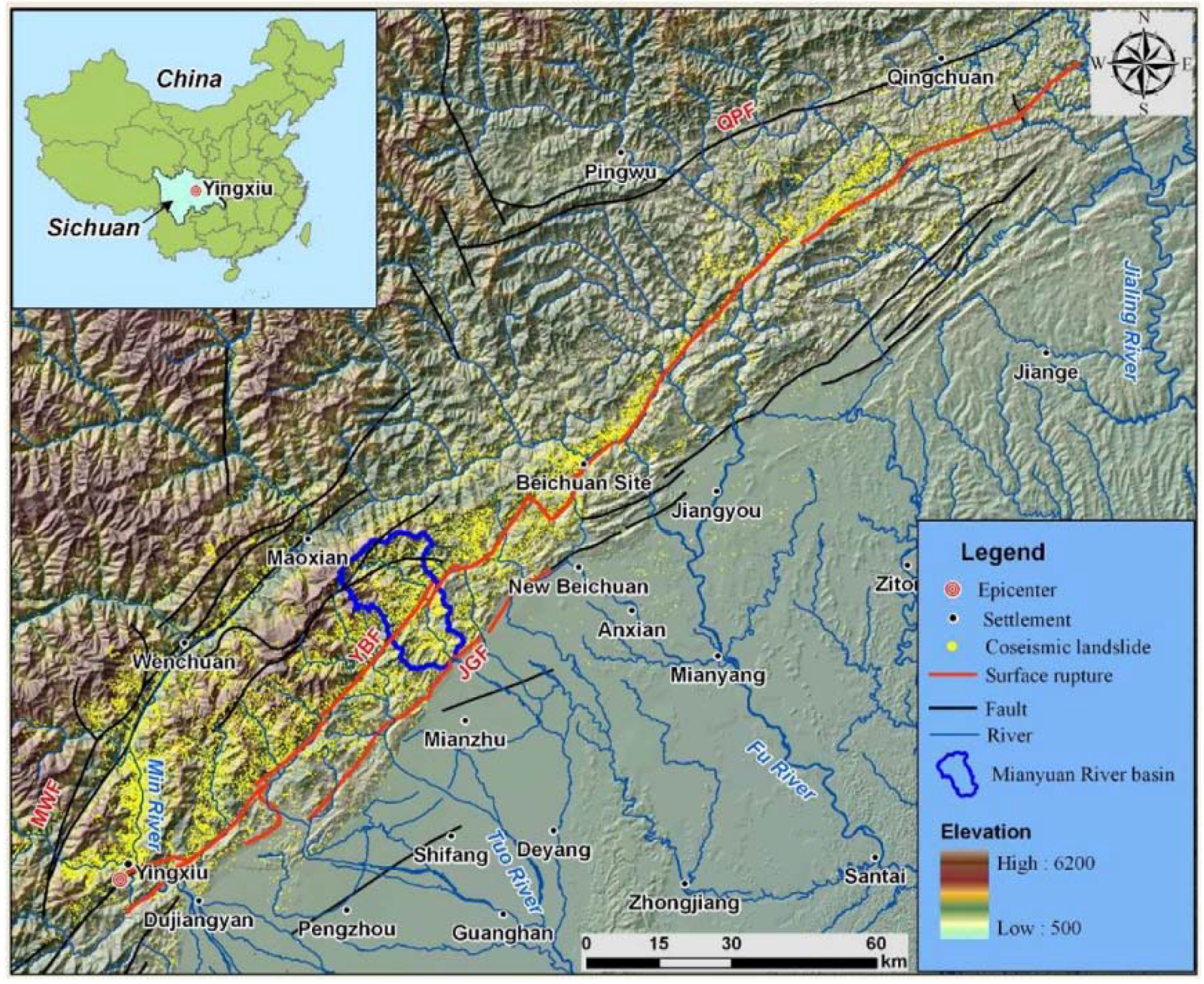
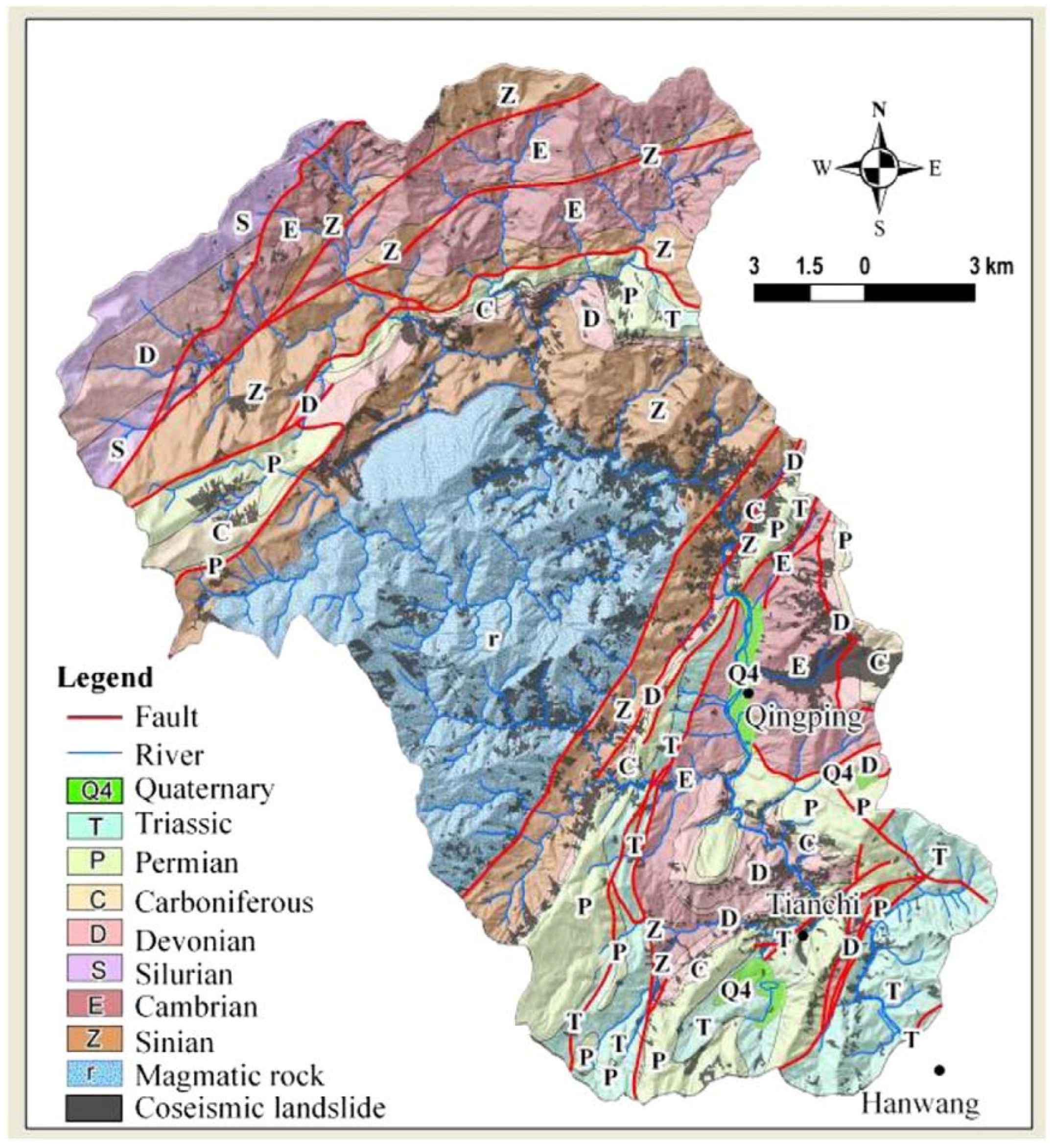

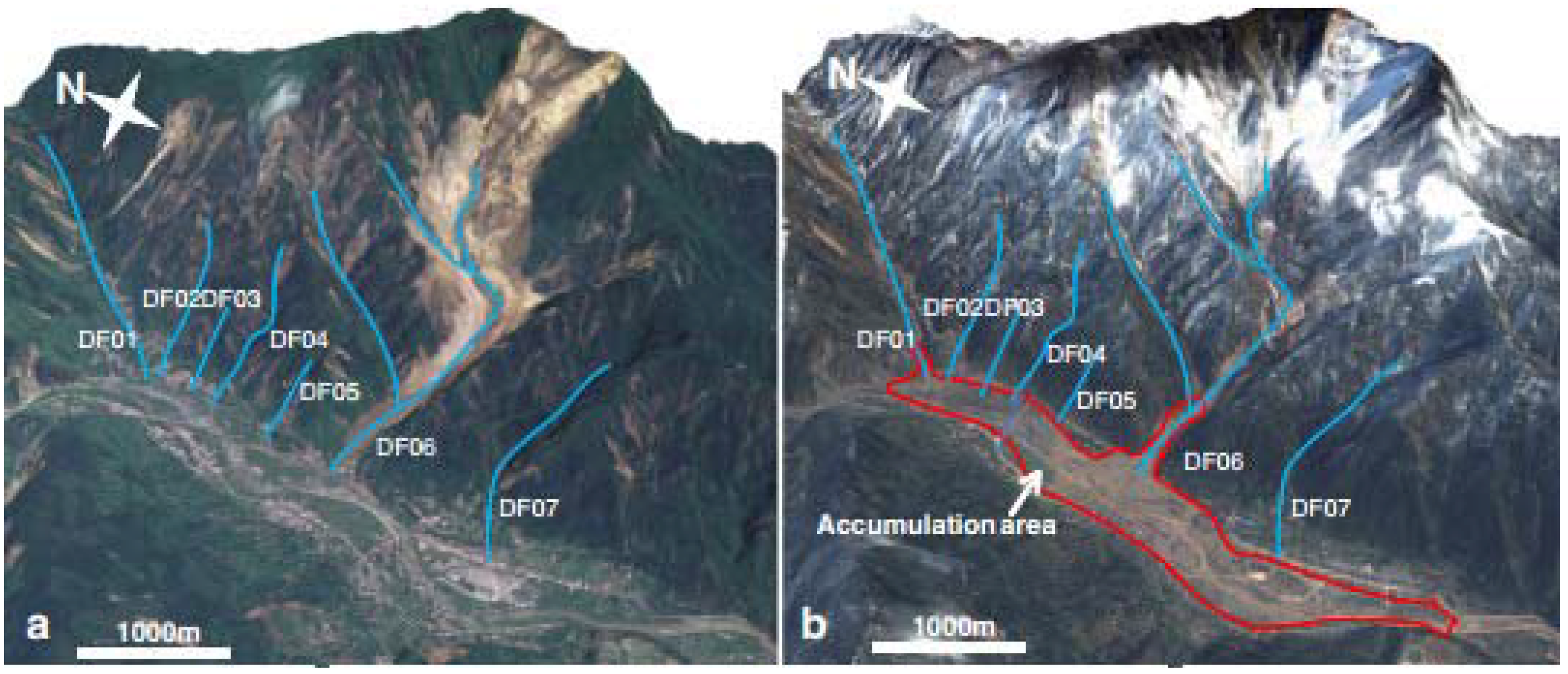

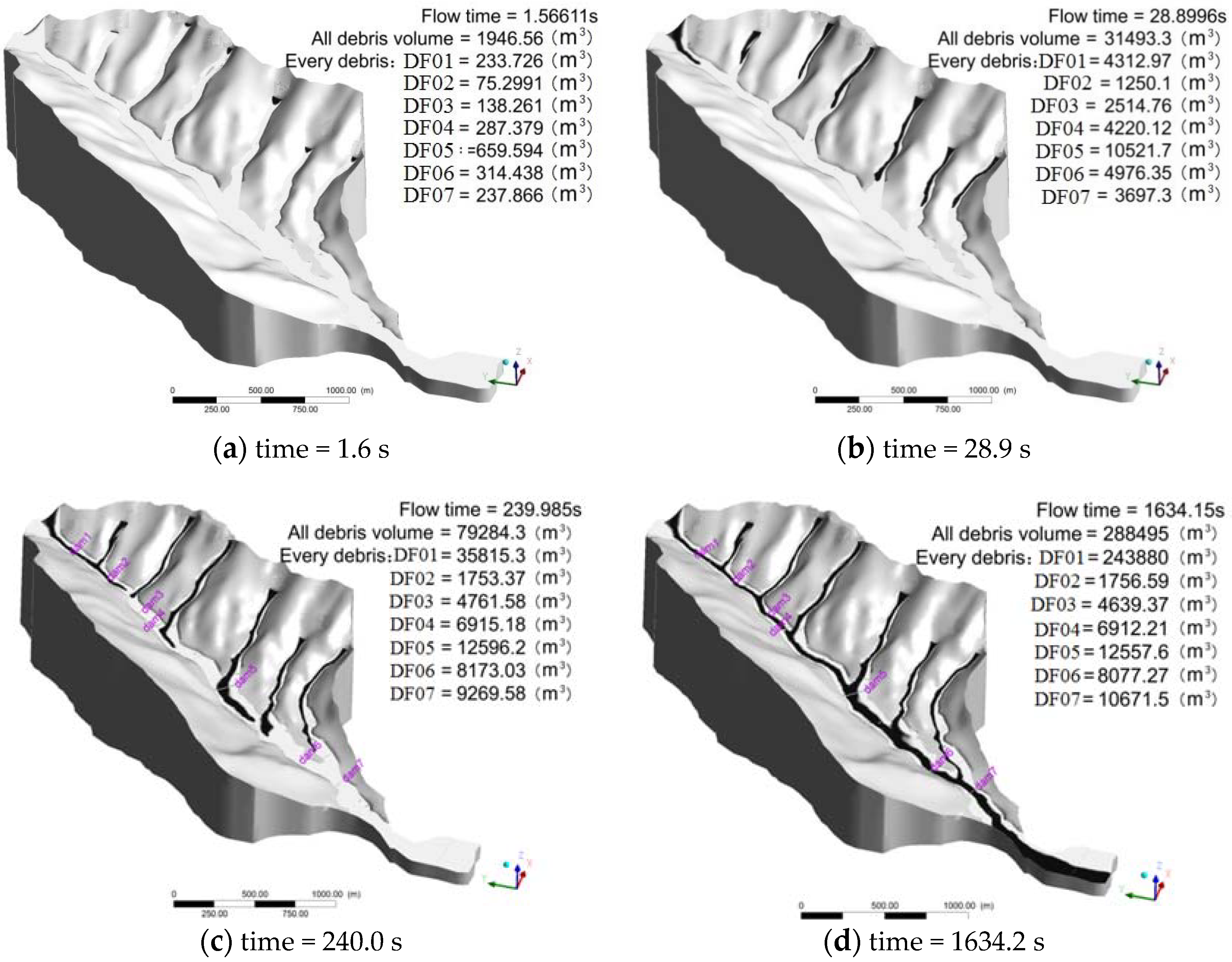
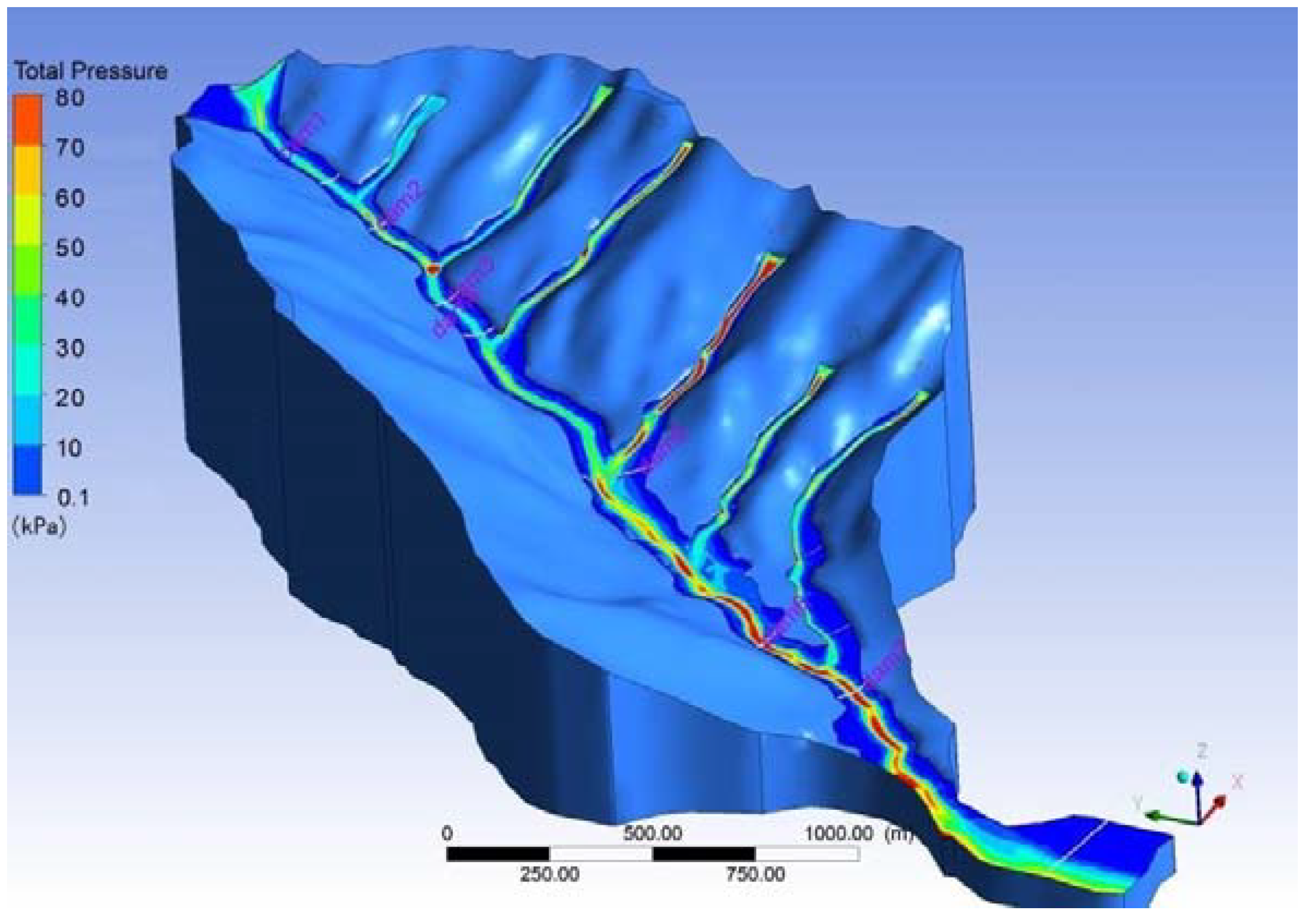
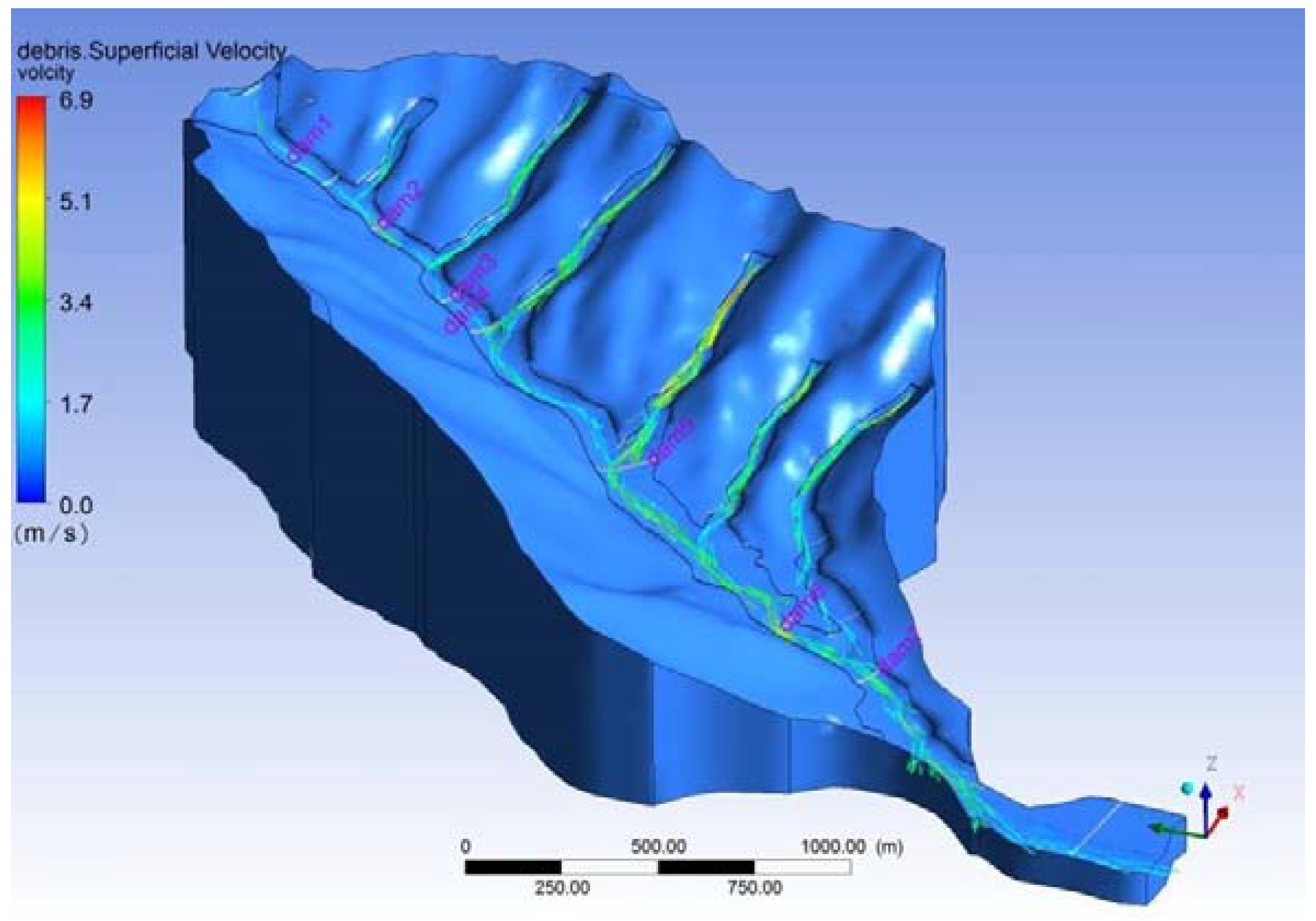
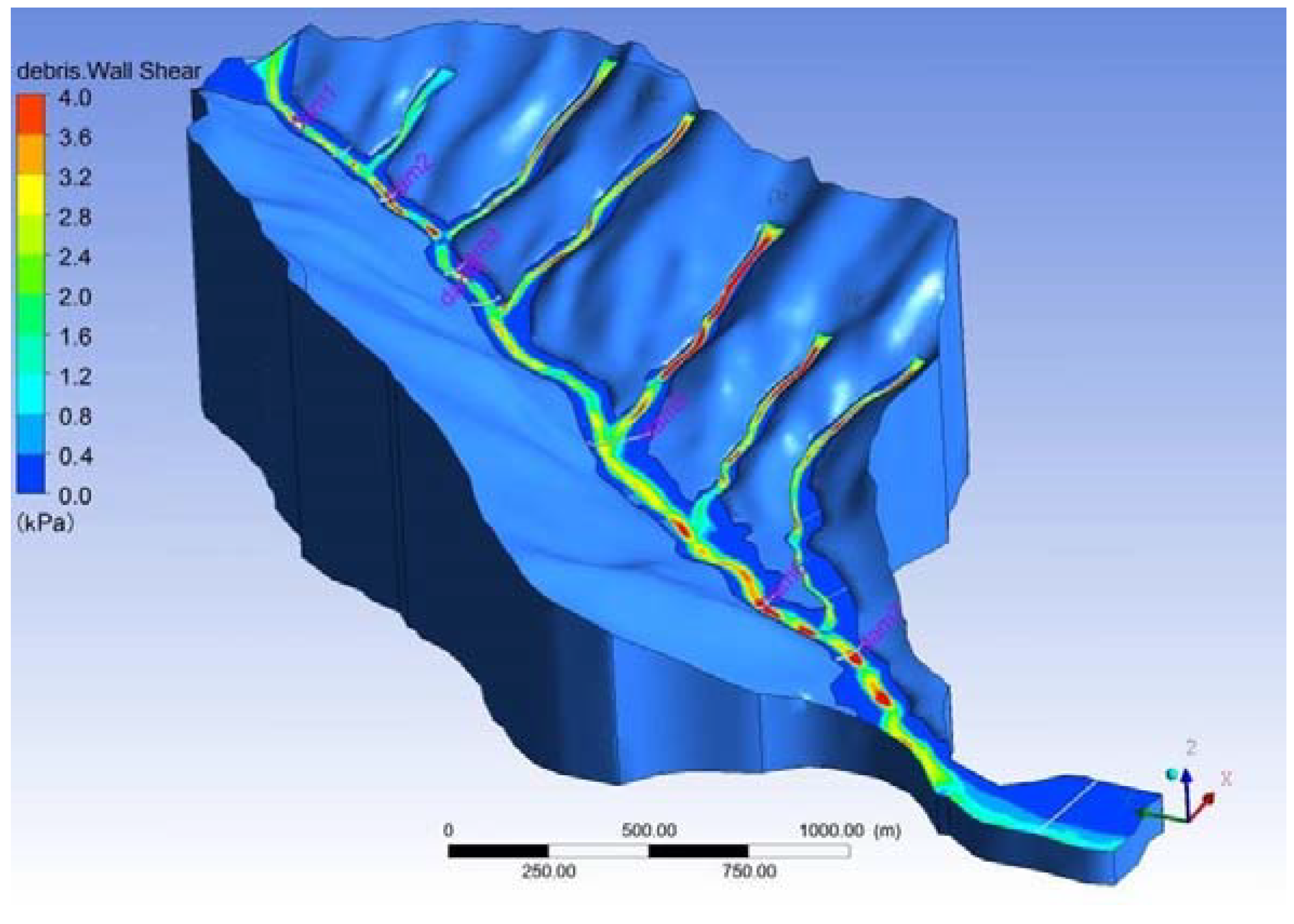
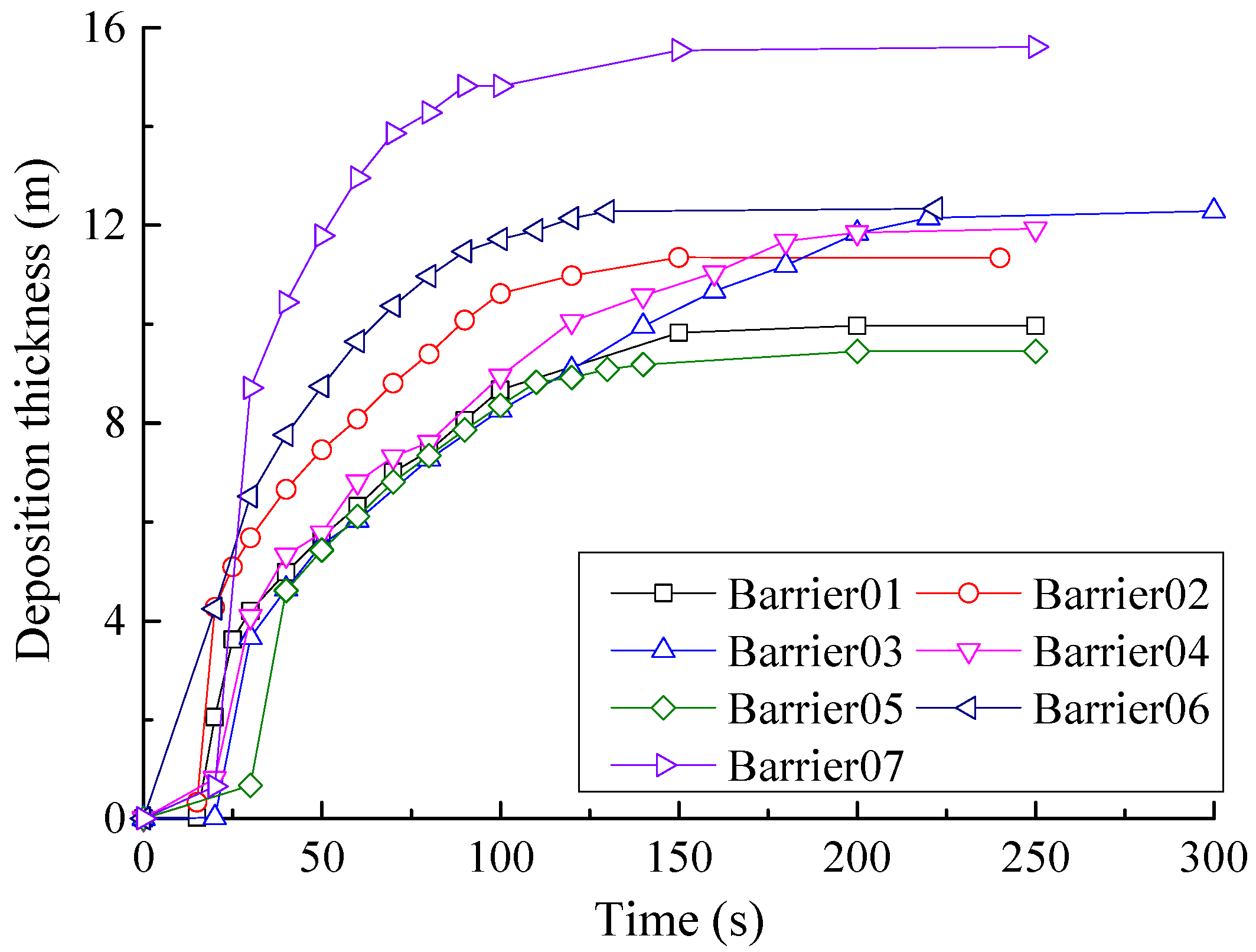
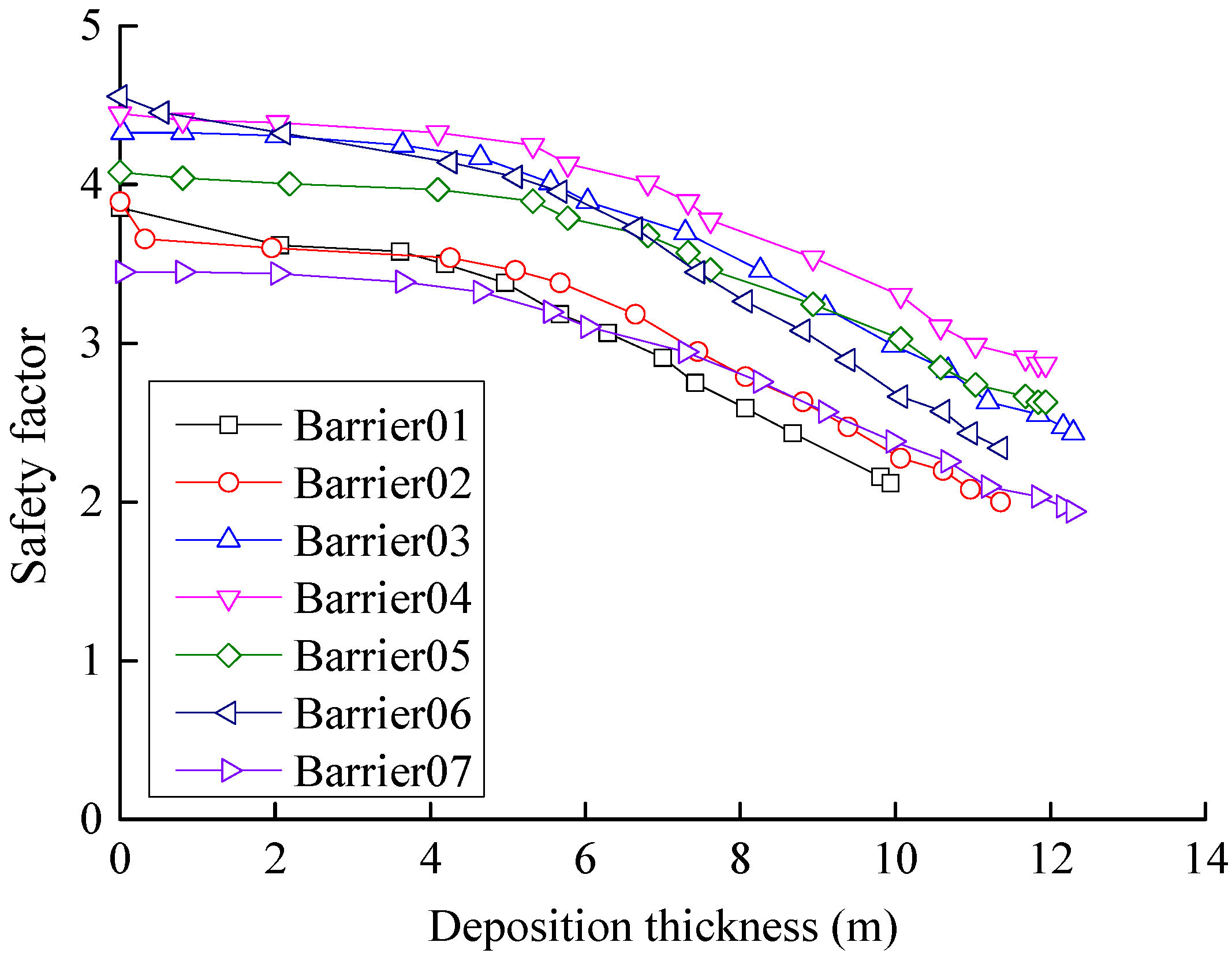
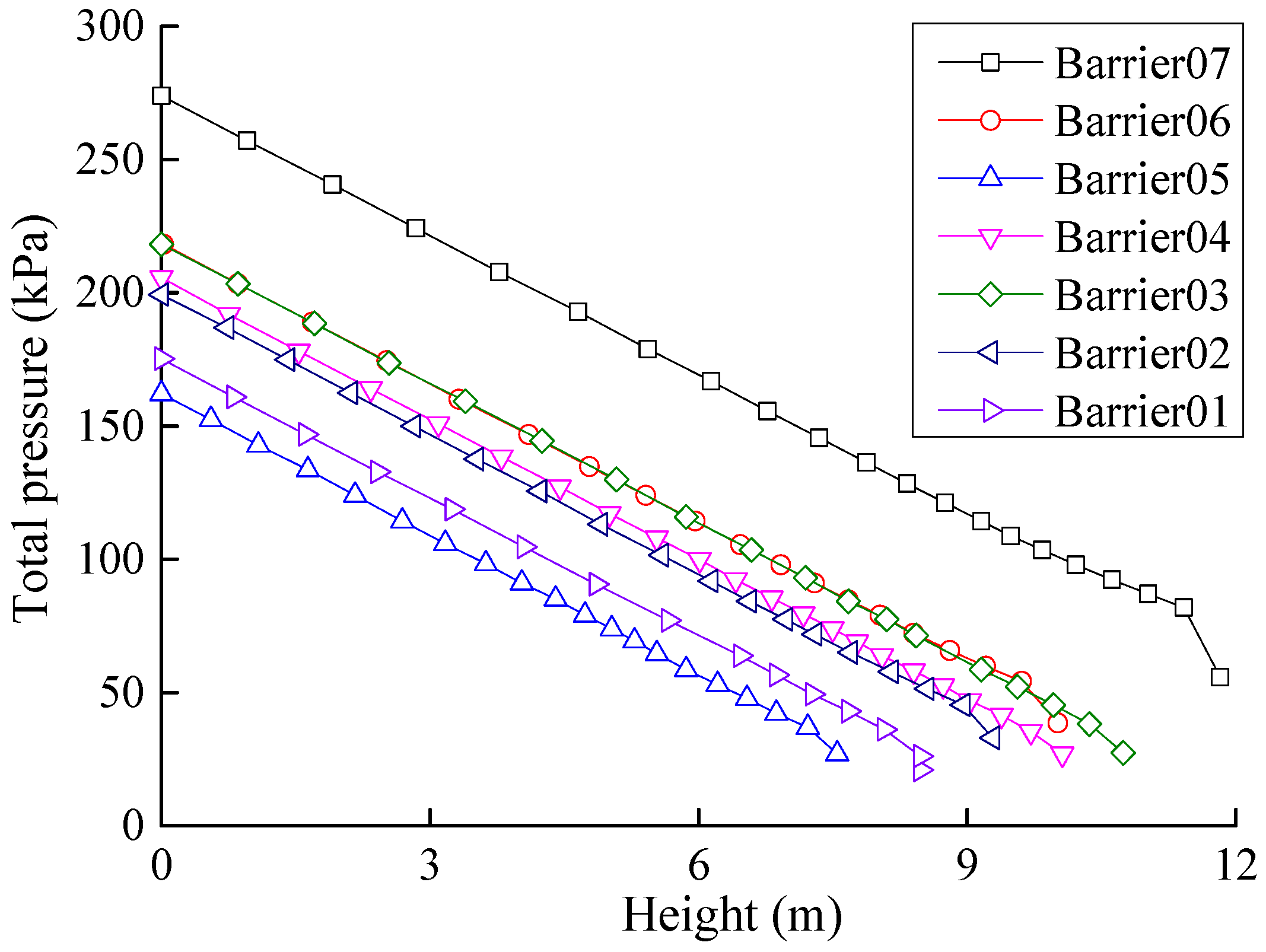

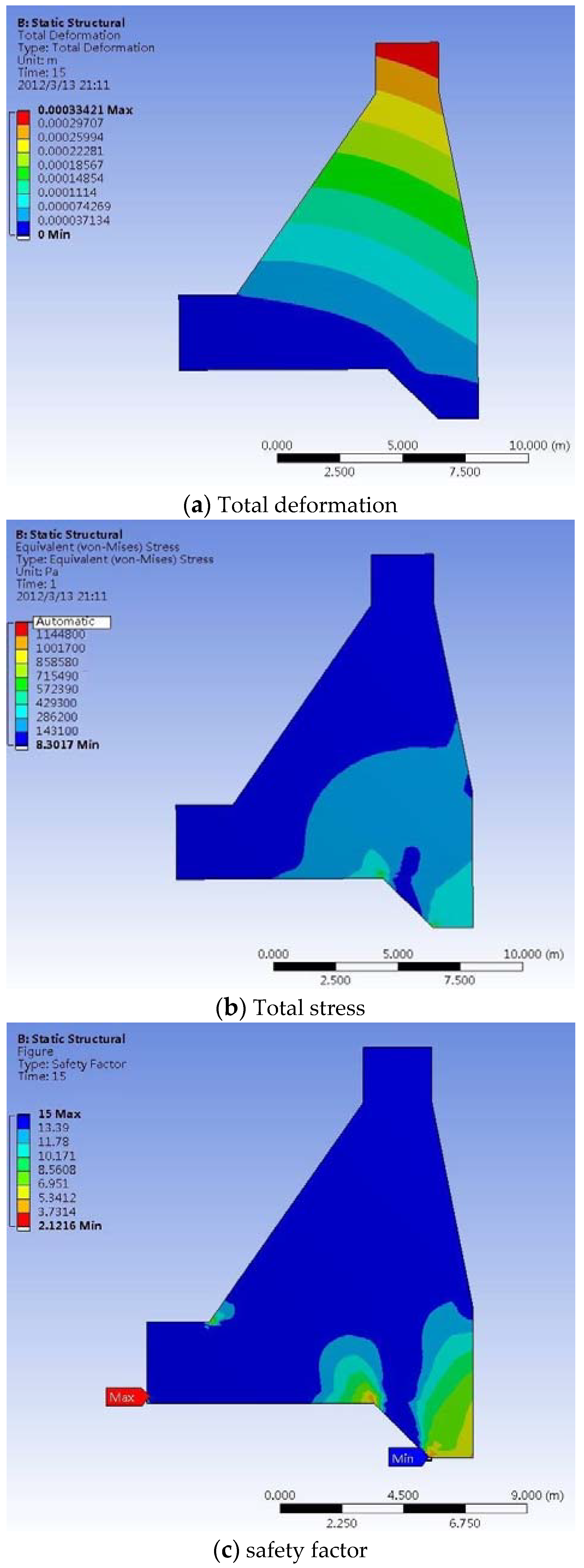
| Position | Velocity (m/s) | Deposition Thickness (m) |
|---|---|---|
| Barrier01 | 2.29 | 1.49 |
| Barrier02 | 5.69 | 0.82 |
| Barrier03 | 2.41 | 1.29 |
| Barrier04 | 3.64 | 0.82 |
| Barrier05 | 5.69 | 0.58 |
| Barrier06 | 7.83 | 0.84 |
| Barrier07 | 6.92 | 1.83 |
| Outlet | 2.75 | 1.81 |
| Barrier | 01 | 02 | 03 | 04 | 05 | 06 | 07 |
|---|---|---|---|---|---|---|---|
| Max shear stress (Mpa) | 1.22 | 1.29 | 1.05 | 0.898 | 0.332 | 0.456 | 0.534 |
| Max von –mises stress (MPa) | 2.36 | 2.49 | 2.04 | 1.74 | 0.634 | 0.857 | 1.02 |
| Max equivalent elastic strain (×10−5) | 7.48 | 7.90 | 6.48 | 5.53 | 2.01 | 2.72 | 3.24 |
| Max displacement at crest (mm) | 0.334 | 0.368 | 0.388 | 0.333 | 0.12 | 0.193 | 0.229 |
| Debris flow horizontal impact forces (kN) | 3350 | 3690 | 4800 | 4110 | 2390 | 3870 | 5430 |
| Debris flow vertical impact forces (kN) | 9220 | 9470 | 12,600 | 11,400 | 55,500 | 8360 | 14,400 |
| Barrier antioverturning counter moment (kN⋅m) | 17,600 | 15,900 | 32,400 | 28,900 | 16,400 | 29,900 | 69,500 |
| Safety factor (deposition filled) | 2.12 | 2.01 | 2.45 | 2.87 | 2.63 | 2.34 | 1.94 |
© 2018 by the authors. Licensee MDPI, Basel, Switzerland. This article is an open access article distributed under the terms and conditions of the Creative Commons Attribution (CC BY) license (http://creativecommons.org/licenses/by/4.0/).
Share and Cite
Chen, Y.; Qiu, Z.; Li, B.; Yang, Z. Numerical Simulation on the Dynamic Characteristics of a Tremendous Debris Flow in Sichuan, China. Processes 2018, 6, 109. https://doi.org/10.3390/pr6080109
Chen Y, Qiu Z, Li B, Yang Z. Numerical Simulation on the Dynamic Characteristics of a Tremendous Debris Flow in Sichuan, China. Processes. 2018; 6(8):109. https://doi.org/10.3390/pr6080109
Chicago/Turabian StyleChen, Yulong, Zhenfeng Qiu, Bo Li, and Zongji Yang. 2018. "Numerical Simulation on the Dynamic Characteristics of a Tremendous Debris Flow in Sichuan, China" Processes 6, no. 8: 109. https://doi.org/10.3390/pr6080109





